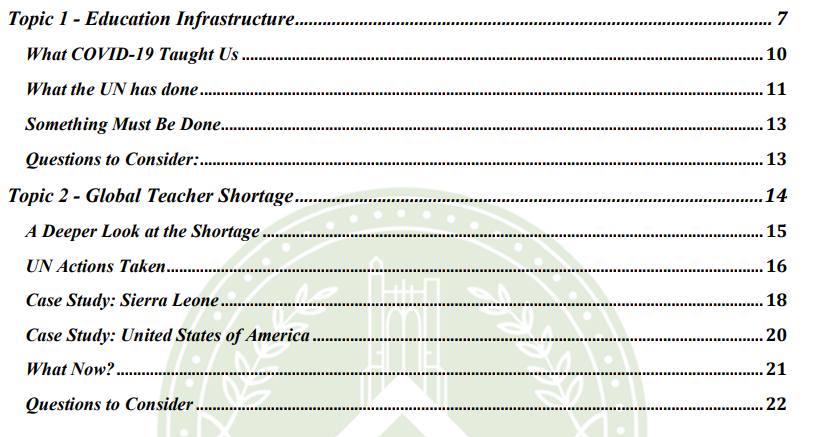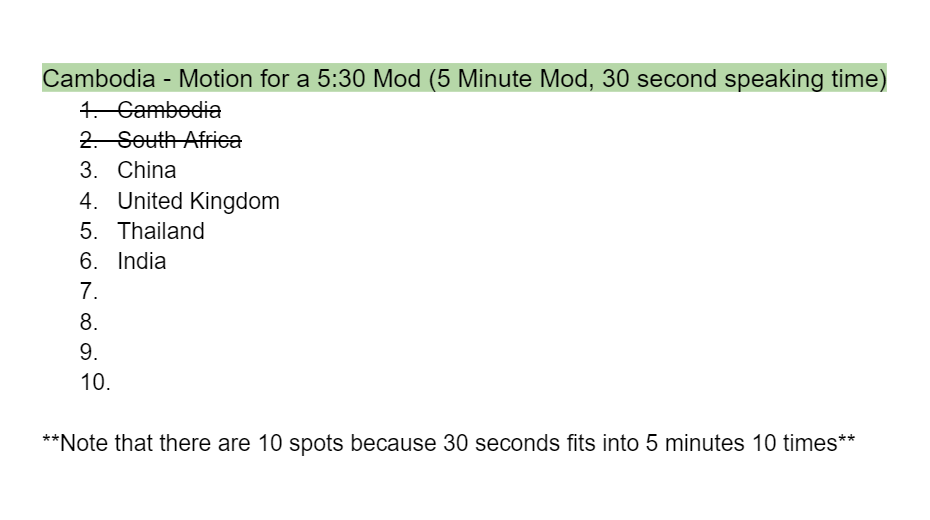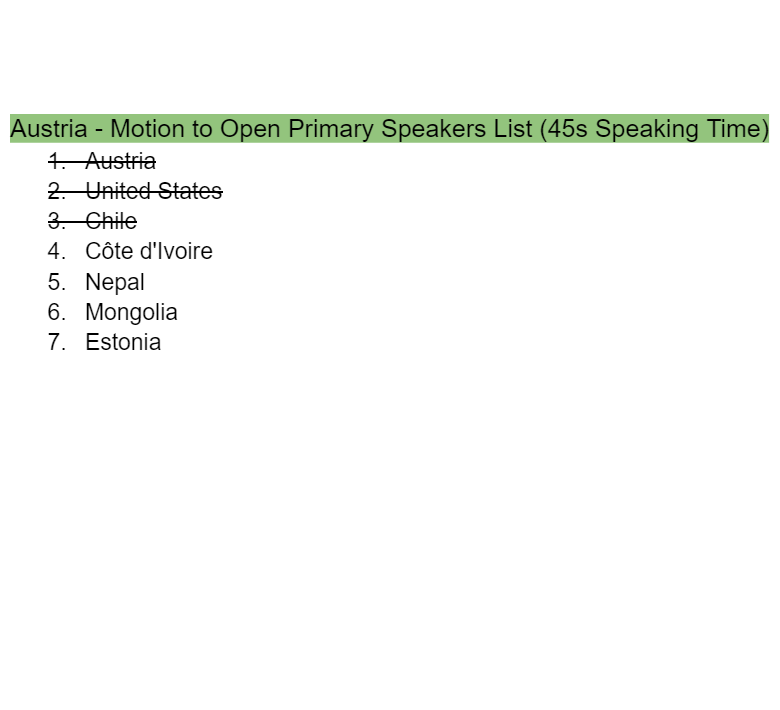
Basic Motions
Motion to Open a Speakers List:
A Speaker’s List refers to the list of countries or delegates who have expressed their intention to deliver a speech during formal debate sessions. It allows for an organized and structured debate where all delegates have an opportunity to voice their opinions and contribute to the discussion. A delegate proposing to open a speaker’s list will set the time, which typically ranges from one to two minutes. Once this motion passes with a simple majority, the chair will call for delegates to raise their placards if they wish to be on the speaker’s list. The chair will note down the names of countries/delegates in the order they raised their placards. This will create the Speaker’s List. Delegates are called upon to speak in the order in which they appear on the Speaker’s List. The delegate can then deliver their speech, expressing their country’s or delegation’s perspective on the topic discussed, propose solutions, express opinions or offer insights.
At the end of a delegate’s speech, they can yield the rest of their time to the chair, to another delegate, or to questions.
There are two types of Speaker’s List: a Primary Speaker’s List, and a Secondary Speaker's List. A Primary Speaker’s List is used right when debate opens so discussion can occur on which topic to debate. Once a topic is chosen by the delegates, a motion to open a Secondary’s Speaker’s List can be made. This is when debate on the topic chosen will occur.
Once you open the Speaker’s List, you don’t need to reopen it again. If motions made all fail, you will automatically return to the Speaker’s List until more motions are made.
*It is unlikely that this motion will be made in a crisis committee
Motion For a Round Robin
A Round Robin is a variation of a moderated caucus in which every delegate in the room gives a speech. The delegate proposing the Round Robin will set the speaking time, topic, and whether they will speak first or last in the speaking order. Round Robin’s require both a speaking time and a topic in their motion. Since everyone in the room will speak during a Round Robin, speaking times tend to be short – typically between :15 seconds to 1:00 minute. A typical Motion for a Round Robin would sound something like: “I motion for a :30 second Round Robin on reactions to the crisis drop”.
Mostly used in crisis committees and small GA/Specialized committees.
Chair will go down the roster list and call on members to speak.
Motion to Enter Voting Procedure
The voting procedure in Model United Nations (MUN) conferences follows a structured and formal process to decide the fate of resolutions, amendments, and other motions.
First, a request for a vote must be made. Before voting on any matter, a delegate or the Chair of the committee will call for a vote. This usually occurs after adequate debate and discussion have taken place.
The Chair will recognize the delegate who has called for the vote. The delegate should clearly state what they are calling for a vote on (e.g., a resolution, an amendment, a motion, etc.)
When making a motion to enter a voting procedure, a delegate can also mention for and against. Delegates can state their positions or reasons for voting in favor, against, or abstaining from the matter being voted on.
When finally entering the voting procedure, three types of votes can be motioned for.
Roll Call Vote: Here, each delegate is called, and they respond with “In favor”, “Against”, or “Abstain”. If they say “Present and Voting” during attendance, they cannot abstain in votes. This ensures transparency and records each delegation’s vote.
Show of Hands: In less formal settings or when time is a factor, a show of hands may be used. Delegates raise their placards to vote “In favor”, “Against”, or “Abstain”.
Secret Ballot: In sensitive situations, a secret ballot may be used to maintain anonymity. Delegates write their votes on a piece of paper, which is then collected and counted by the Chair or a designated official.
Outcome of the Vote:
Majority Required: Resolutions and most motions usually require a simple majority to pass. This means that the motion or resolution passes if it receives more votes in favor than against.
Supermajority (2/3rds majority): In some cases, special resolutions or amendments might require a higher threshold, such as two-thirds majority, to pass.
Failure to Pass: If a resolution or motion fails to achieve a majority of votes in favor, it is not adopted.
After all the votes are casted and counted, the Chair announces the results along with the number of votes in favor, against, or abstentions.
Motion to Introduce an Amendment
An amendment in a way to propose changes or additions to a draft resolution that is being discussed by the committee. It allows delegates to modify specific aspects of the resolution to better address the concerns and ideas raised during the debate. Before the amendment is introduced, it must be submitted to the chair. Once the chair approves of the amendment, a motion to introduce the amendment is made. There is no speaking time. Once the amendment is introduced, a moderated caucus tends to follow to see the general reaction of the amendment, specifically the sponsors. If they are on board with it, the amendment becomes a friendly amendment and can be added to their resolution without voting it in. If they do not support the amendment, it becomes an unfriendly amendment, and it needs to be voted in. A motion to amend the resolution must be made. In this case, a second is needed. Then, using a simple majority, a vote can be made for the amendment to be adopted or rejected.
Motion for an Unmoderated Caucus (unmod)
An unmoderated caucus constitutes a suspension of the rules that allows delegates to freely convene and converse freely with one another. Unmoderated caucuses require a set length of time but do not require a speaking time or a topic. A typical motion for an unmoderated caucus will sound like: “Motion for a 10 minute unmod”. This allows for delegates to move around the room, write together, and hold conversations outside of rigid debate.
Motion to Set the Agenda or Topic:
Setting the “agenda” or “topic” in committees refers to picking a particular overarching topic or agenda point that debate will revolve around. This is particularly important because it limits delegates to only talking the voted on topic and discussions that deviate too much can be ruled dilatory by the chair.
This motion is generally only employed in GA or Specialized committees and limited to the Topics specifically outlined in the Background Guide.
Motion For a Moderated (Mod) Caucus
A moderated caucus is a form of debate where the speaker’s list is placed aside (if you ever started with a speaker’s list) and a new set of speakers is chosen to speak on a specific topic for an allotted time. Moderated caucuses tend to be where the majority of debate takes place during a committee session. A motion for a Moderated Caucus requires a topic, speaking time, and overall time. The delegate who raised the motion will also choose whether they speak first or last in the “mod”. A typical motion will sound like this: “Motion for a 5:30 on Determining the Legal Status of Climate Refugees”.
In the above example, “5:30” is a shorthand for the overall time for the caucus and the speaking time. This moderated caucus would be five minutes long with each speaker speaking for :30 seconds. This is generally how people will motion for and accept mods but if you are ever confused you can always elongate the phrase rather than apply the shorthand: “I motion for a 5 minute moderated caucus with a speaking time of :30 seconds on Determining the Legal Status of Climate Refugees”.
Motion to Introduce Resolutions/Directives
Delegates need to first submit the resolution/directive to the Dias to be approved. Once approved, delegates can raise either placard to get the Chair’s attention. When the chair recognizes the delegate, the delegate can state that they want to motion to introduce a resolution on the topic of [the topic at hand]. When the chair recognizes this motion, the sponsors of the resolution/directive can go up and present the papers. Delegates can also motion for a set amount of time for a Q&A following the introduction.
Motion for a Question and Answer Period
A Question and Answer Period (Q&A Period) refers to a segment of the formal debate where delegates have the opportunity to ask questions of the speaker who has just delivered a speech or introduces a resolution the the committee. It allows for further clarification, the opportunity to challenge certain points made in a speech, and an exchange of ideas among delegates. This period enhances the interactive and dynamic nature of UN debates. A delegate can motion for a Q&A Period and set the time. Time is paused when other delegates ask questions. Delegates will raise their placards and be called upon the chair to ask their questions. Depending on the time, follow up questions can be asked. Ask your chair to ask permission for a follow up question, and they may permit it.
Motion for a One-For-One-Against
A One-for-one-against (or two-for-two-against) motion commonly occurs either when a committee is already in voting procedure or when a committee is about to move into voting procedure (and will typically be combined into the same motion). One-for-one-against speeches allow for the main issues, benefits, and concerns with papers being voted on without holding a long period of debate on the papers. It allows for members of committee to weigh the pros and cons of voting for a paper in a very timely manner and may point to how papers must be amended before their passage. A one/two-for-one/two-against motion must include a speaking time.









